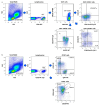Anifrolumab Attenuates Follicular Helper T Cell Activation in Patients with Systemic Lupus Erythematosus
- PMID: 40806526
- PMCID: PMC12347037
- DOI: 10.3390/ijms26157397
Anifrolumab Attenuates Follicular Helper T Cell Activation in Patients with Systemic Lupus Erythematosus
Abstract
Systemic lupus erythematosus (SLE) is a severe autoimmune disease characterized by autoantibody production and multi-organ involvement. Anifrolumab, a monoclonal antibody targeting the type I interferon (IFN) receptor, has been approved for the treatment of SLE. Our aim was to investigate the long-term effects of inhibited type I IFN signaling on circulating follicular helper T subsets (TFH), follicular regulatory T cells (TFR), and B lymphocyte subpopulations, reflecting the ongoing germinal center reactions in SLE patients. Peripheral blood samples were obtained from ten SLE patients before the initiation of anifrolumab treatment, and at months 6 and 12 of the intervention period. Flow cytometry analysis was performed to assess the frequencies of circulating TFH cell subsets, TFR cells, and certain B cell subpopulations. Serological parameters, including autoantibody levels and complement components, were determined as part of the routine diagnostic evaluation. We observed a significant and sustained reduction in the percentage of activated circulating TFH cells. Notably, the frequency of CXCR3-CCR6+ TFH17 cells decreased, whereas the proportion of CXCR3+CCR6- TFH1 cells increased significantly. Furthermore, the proportion of the IgD-CD27- double-negative B lymphocytes was also significantly reduced. These findings suggest that anifrolumab therapy attenuates TFH cell activation, which may contribute to its clinical efficacy by modulating germinal center responses in SLE.
Keywords: anifrolumab; follicular helper T cells; systemic lupus erythematosus.
Conflict of interest statement
The authors declare no conflicts of interest.
Figures



References
MeSH terms
Substances
LinkOut - more resources
Full Text Sources
Medical
Research Materials
Miscellaneous

